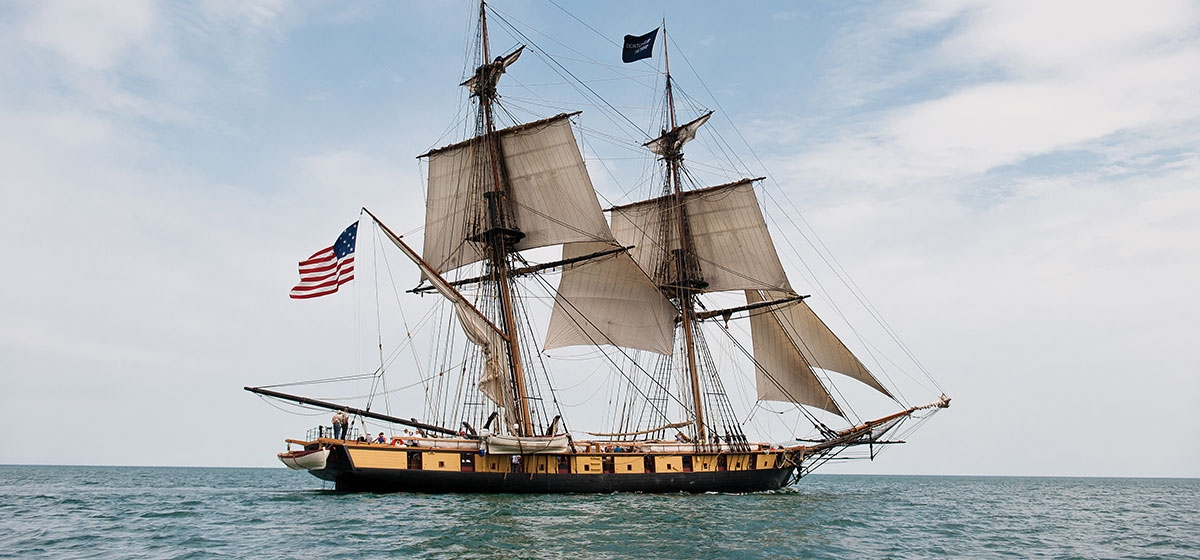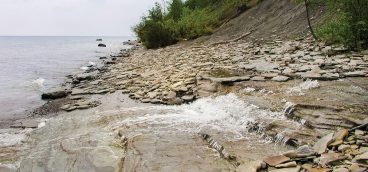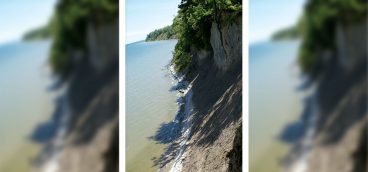The Watery Part of the World

The standing watch was sent below for wet- weather gear, and the clattering of their feet on the ladder awakened me. I headed above deck, blinking in the light and trying to align the fair skies behind us and the gentle roll of two-foot waves with the urgency of the crew laying out the line—called the rode—for the anchor on the deck. A mass of dark cloud crackling with lightning was bearing down on us.
[ngg src=”galleries” ids=”64″ display=”basic_thumbnail” thumbnail_crop=”0″]
“What’s going on?” I asked. “We’re making a run for it!” came the reply. “There’s home, ahead!”
Sure enough, up ahead was Erie, Pennsylvania. Presque Isle peninsula on the starboard bow, the bluffs of Harborcreek on the port beam. I could see the buoy marking the entrance to the harbor’s channel and beyond, the smokestack next to the Erie Maritime Museum, behind which was the Niagara’s pier. We were 30 minutes from home. But the storm was already across the peninsula and nearly on us.
The ship was still in disarray from our passage through the Welland Canal that morning. All of the Niagara’s yards were cockbilled, tilted and turned parallel to the ship. Likewise the davits—the arms that stretch over the ship’s rails to carry her boats—had been removed and placed on deck. Returning to Erie through the canal locks meant sailing through enormous metal doors into giant concrete boxes, which were filled rapidly with water. Any overhanging part of the Niagara would likely be snapped off as the ship swirled with the current against the locks’ concrete walls. So they had been moved out of the way.
It was the third of July, and we’d already been hit by one storm that day—pelted by sideways hail and buffeted by gusts. I had stood by the windward bulwarks frozen with fear, remembering again that the Niagara was tippy, built along the same lines as her 1813 counterpart. That Niagara had been constructed in Presque Isle Bay with a 9-foot draft so she could be hauled across a sandbar that protected Erie from the British during the War of 1812, but that shallow draft also made her susceptible to strong wind. This Niagara had an 11-foot draft, a historically inaccurate concession to stability, but it was still shallow enough.
The Niagara is a reconstruction of Oliver Hazard Perry’s ship that broke the British line at the Battle of Lake Erie. It was perhaps our nation’s most decisive battle in that odd conflict that started ostensibly over the rights of American vessels and sailors on the high seas, but whose epicenter was the Great Lakes. Perry is most remembered for his quote, “We have met the enemy and they are ours,” and his victory enabled American control of Lake Erie. That, in turn, allowed William Henry Harrison to march on Detroit, defeat a British army there, wreck the nascent confederation of Indian tribes opposing American expansion on the frontier, and provide the accolades that would win him the presidency.
The Niagara is a brig—a two-masted, square-sail wooden ship—the biggest of her kind plying the lakes, and still flying Perry’s flag: white letters on a blue field that say “Don’t Give Up the Ship.” The ship had been reconstructed twice before for anniversary celebrations, but only in the 1980s was she built to sail the lakes. Her stewards at the Flagship Niagara League envisioned the Niagara as a sail training ship and hired a captain and professional crew to run it. The ship now carries trainees, as well as groups of high school or college students who pay to be aboard, but also volunteers like me who exchange work during the ship’s winter maintenance for summer sailing time. I had traded hours of splicing, seizing, serving and tarring line, and varnishing and painting, for this 10-day cruise to Lake Ontario to reenact the Kingston-area battle for Canada Day.
And now, on my last day, fear gripped me as we faced our second squall. “All hands on deck!” As the crew emerged in raincoats and sou’westers from the hatches, the captain ordered the anchor dropped. In the bow, the boatswain released a line. “Keep away from the rode!” he yelled as the thick line began to play out the hawser hole. The hand at the throttle cut the ship’s engines, and the Niagara drifted backwards with the wind, dragging her anchor until its flukes dug into the lake bottom and held us fast.
We had given up the race. The storm won.
I lost my shoe the very first night of the cruise.
I had slung my hammock in the berth deck and was looking for a place to stash the gear I’d need for night watch, when I saw a shelf-like nook running around the upper edge of the bulkhead. At regular intervals were deeper recesses, perfectly sized for my Converse Chucks. As soon as I put a sneaker there, it disappeared.
Above deck, I sought out Isaiah, my closest friend on the ship. He was a professional crew member, an able-bodied seaman, and we had worked together on ship maintenance last winter. He had taught me my knots and basic seamanship, introduced me to raw milk, and patiently answered my every question. Although he was a decade younger, I called him “Pops.” During the cruise, I’d periodically ask him, “Am I a tallship sailor yet?” He’d shake his head and respond with a hint of a grin in his rural Ohio twang: “Not until you’ve seen a Force 10 storm.”
“I have something embarrassing to admit,” I said, and told him about the shoe.
“You’ll never see it again,” he said. I had put my shoe down the ship’s clamp, he explained, which ran between the outer hull and the bilge and was used for ventilation. “The only way to get your shoe back would be to cut the ship in half.”
I’d need shoes. The deck has a habit of giving out splinters. Isaiah once had a deck splinter wedged so far under his fingernail it reached the first knuckle. He offered me his valued Red Wings—handsome red-leather boots maybe only a half-size too big. I took them.
As Ishmael said in the opening lines of “Moby Dick,” “Having little or no money in my purse and nothing in particular to interest me on shore, I thought I would sail about a little and see the watery part of the world.” Such words belie the dreamy beauty of a wooden sailing ship. Who, having seen such a sight, hasn’t wished to sit on the crosstrees of a tall ship under full spread of sail?
But the work is dirty and hard, and the living conditions cramped. Forty of us inhabited a space that’s 120 feet long and 30 feet wide. Most of the crew sleeps and eats in the berth deck, a tiny space just five feet high. We sling hammocks at night and eat at tables and benches we disassemble after each meal. And compared with 1813, we had it easy. The original crew of 150 subsisted on salt beef and horse, and were sometimes cruelly beaten. They didn’t have engines, life rafts, or harnesses with carabiners for climbing aloft. Sanitation was unknown, sickness rampant. As many as a quarter of the seamen were sick with dysentery-like symptoms on the day of the Battle of Lake Erie.
The crew and the work are as much a part of the ship as her sails and the rake of her masts. If the Niagara is a machine, her crew are the cogs and wheels of muscle, sinew and bone who crawl about the deck and rigging, lending their bodies to the ship. “These aren’t my friends,” said one of the professional crew. “This is my crew. I am trusting my life to them.”
The hands haul the rode to pull the ship to its anchor. The hands haul on synthetic line, and on evil manilla with its cruel little splinters tearing blisters. And in battle, the crew mans the guns and absorbs the splinters from the bulkwark shattering under enemy shot. If this spoils the Errol Flynn and Johnny Depp romance of the Niagara, it also provides something more valuable in return. As a member of the crew, you are trusted. Relied on. Needed. Working the Niagara gives the humbling first-hand experience of knowing real work, of making something go.
Proving yourself, however, and becoming part of that crew isn’t easy. Trainees are divided into watches, each led by a mate and an able seaman (AB), who acts as a kind of sergeant, carrying out the officer’s orders and assigning the hands to tasks. The watches take turns handling the ship, manning the tiller, acting as lookout, conducting regular ship inspections, and performing the chores that keep the Niagara in working order: cleaning dishes, washing the deck, taking in or letting out sail. The watch system works 24 hours a day. Your watch sees everything you do, and your AB notes your performance.
I often failed. The first time I climbed up past the crosstrees wearing Isaiah’s boots, one of the professional crew, Starbuck Derderian called me to help unfurl the fore topgallant (pronounced t’gallant) sail. She was my first and best teacher on the ship. Short, dark, and blade thin, she could at times be foul-tempered and at others joyous and expansive. She loved sailing on the Niagara. It infused every pore of her body, and with her poetry degree from the University of Massachusetts, I thought of her as Emily Dickinson escaped to sea.
I quickly followed her up into the rigging. The shrouds below were widely spaced for climbing with plenty of ratline to stand on. But way up, above the fore top, the shroud narrows quickly. The ratlines disappear, replaced by ratboards no wider than three or four inches. The last is the smallest, and then it’s a long step—almost a jump—to the crosstrees, which is nothing but a squarish metal hoop on the mast 100 feet above the deck. Isaiah’s steel-toed boots made it almost impossible to feel the last ratboard with my toes, so I had to place my feet sideways to get much of a grip. As the ship pitched through the waves, I launched out for the crosstrees. I grabbed it, pushed my upper body through the hoop and pulled myself up.
By the time I sweated myself through to the crosstrees, Starbuck had already been waiting a little while. She prodded me up to the t’gallant yard and said, “You know what to do, right?”
Yes. Of course I did. I had unfurled sails a dozen times. But all I could think of was coming up through the crosstrees, and of how small the t’gallant yard was, and how loose the footrope was. And every time the ship rolled, I was pitched forward onto the yard. My instincts screamed I should hug the yard and never let go, but I knew if I did that, my center would be so far forward that I could be pitched over it to dangle in midair by my harness from the backrope, akin to hanging off a rolling, loping 10-story building. That is, if the backrope held.
“What are you doing?” Starbuck yelled. “Don’t you remember how to do it?” She laughed at my fear and walked me through it. We unfurled the sail together.
The Niagara is a reconstruction of a 200-year-old ship. And she does have cannon. Or, more accurately, six carronades, which are snub-nosed guns capable of firing larger shot, but with little accuracy at any distance. The original ship had 18 carronades and needed to get close to the British to do any damage. But during our Canada Day battle re-enactment, we didn’t have to worry about range. We were shooting black powder cartridges only.
For the two-day skirmish, we played the part of the British corvette, the Royal George, which had been ambushed by a flotilla of smaller American vessels and chased into Kingston. The actual historic battle was like something out of a Benny Hill montage, as the American ships swarmed around the Royal George trying to board and take her, while she responded with sloppy and infrequent broadsides, and the nearby forts fired ineffectively with guns too small to do much damage or to shoot very far. The Americans withdrew, likely more out of frustration than in fear, but their chance to dominate Lake Ontario and all of Upper Canada ended there. The British beefed up the harbor’s defenses and built more warships. The two navies remained stalemated on the lake for the rest of the war.
Our re-enactment took place in midsummer, not in a November fog, and that first day we were “chased” by smaller vessels, mostly schooners, splayed out behind us, their parchment-colored sails spread wide, little puffs of smoke announcing their fire on Amherst Island’s shore battery. We could feel the shock of their guns across a mile of water like a faint crumpling under our feet.
It was later that night that I really got to experience the guns. We fired rolling broadsides at the village of Bath, which had been invaded by re-enactors playing American soldiers. I was assigned to the starboard gun crew, tasked with providing the tools to clear the cartridges and clean the carronade for reloading. Carefully, another member of the crew would place the 3-pound, tinfoil-wrapped cartridge into the gun, where it was tamped into place by another hand. Once primed, it was ready to fire. In a real battle of the era, shot was added after the cartridge.
I often stood only a few feet from the firing guns. I wore earplugs and covered my ears, but the shock of firing was so immense it shook my eyes in their sockets. Every time a gun was fired, flame would leap out the vent at the top of the gun as well as out its mouth—an effect only highlighted in the darkness. The guns literally belched fire and spark, and a large cloud of white smoke lingered over the water for several minutes.
We fired gun after gun. Loading, cleaning, reloading, hauling on tackles to run the guns in and out of the gunports. One of my jobs was to catch the spent powder cartridges in a bucket of water as they were cleared from the guns, and soon my bucket was full of a foul-smelling sulfuric concoction slippery to the touch. When it slopped over on my legs and shirt, it stained them green.
The battle seemed timeless and was great fun. But to the Canadians watching, crowding around the Niagara in their sailboats and motorboats, and to the middle-age re-enactors playing Redcoats in our fighting top and shooting off muskets, the battle and our ship represented something bigger. The defeat of an invading army, and the acquisition of a national identity. Until the War of 1812, people north of the border were a loose confederation of French trappers, British soldiers, former American Loyalists who’d fled north after the Revolutionary War, and hardscrabble farmers who had emigrated north from New England. When the Americans invaded, for the first time this disparate group thought of themselves as Canadians.
The storm hit us fast. The wind was up in seconds. Rain began to fall. The captain crouched on the quarterdeck, drenched. His face was bright red, and he peered forward with an almost enraged expression. Someone shouted in my ear. “Close the skylights in the wardroom!” I plunged down the ladder in the aft hatch to the officers’ spacious eating area and stood, dripping wet, on their table to reach the overhead windows, propped open with pencils. I removed them and battened the windows shut.
I got back on deck, and the captain shouted: “PFDs!” There was a pause. Life jackets? I raced to the deck box where they were stored and ripped off the box cover. I grabbed handfuls of jackets and thrust them at people. The rain came in torrents. I emptied the box and yelled, “I don’t have one!” Someone shoved a PFD into my hands and I put it on, tied it, and someone reached out and tightened the chest strap so tightly it caught my breath. It seemed only seconds had passed, and every member of the crew was wearing a life jacket.
Life jackets? What did this mean? I imagined the ship turning over and me plunging into the cold water. The wind would surely scatter us. How long would it take for the Coast Guard to arrive? We were right outside the port, but we were in the middle of the cloud and I couldn’t see land—or anything more than 30 feet away. Lightning crackled all around and a high school student said, “I’ve never been so scared in my life!”
The wind hit like a slap. The rigging moaned. I thought, “Here we go.” And then it was gone. It suddenly began to pour. The sky just emptied on us, but it was still already lighter. We were drenched and cold, but ecstatic.
Had anyone seen anything like this before? No. Once, but at anchor. Never, said Mariah, which surprised me, because she had served on an ocean-going schooner. How fast was the wind? Fifty knots said the fourth mate. He must have seen the navigational panel. What kind of storm was that? Force 10.
Twenty or 30 minutes passed before we hauled up the anchor. We were so full of adrenaline we hauled the rode and anchor up in minutes and were soon motoring for home. Later the captain would explain that 40- to 50-knot winds were not dangerous for the Niagara. He explained how dropping anchor kept the ship from turning sideways to the wind, which would be dangerous. He ordered life jackets not because he thought the ship was in trouble, but as a precautionary measure in case the winds blew stronger. Seventy knots, he said, would be a problem.
But, now, as we motored to the channel, most of us stood at the bows peering over the bulwark at Presque Isle peninsula. A strip of cloud had cleared to the west and we watched the sun, golden and resplendent, sink to the horizon.
“That was Force 10,” I told Isaiah. “That means I’m a tallship sailor now.”
“No you’re not,” he said, adding “I said Force 12.”
“You said Force 10.”
“No, I didn’t.”
“You did.”
And on we bickered, to home.
Visit the Erie Maritime Muesum website for information about sailing on the Niagara: eriemaritimemuseum.org/flagship_niagara.





